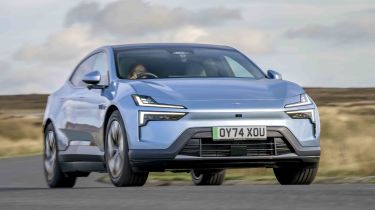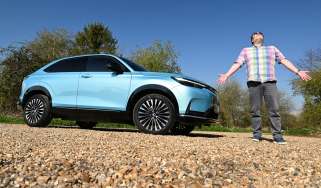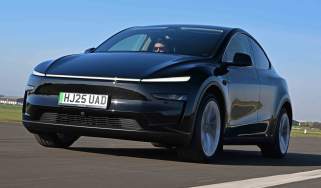Polestar 4 - Electric motors, performance & drive
The Polestar 4 offers a well-rounded driving experience and the ride easily absorbs the bumps on British roads

The Polestar 4 uses the SEA (Sustainable Experience Architecture) platform from parent company Geely, variants of which have been used for electric cars of all shapes and sizes, from the Zeekr X hatchback and Smart #1 compact SUV to the Volvo EM90 luxury MPV and Lotus Emeya four-door GT.
During our testing we found the ride on the firm side, but this does help to give the Polestar 4 a sporty edge that suits its silhouette, and body control is kept in check. Plus it’s still impressively comfortable, absorbing potholes and other imperfections that litter UK roads.
Something else you’ll quickly notice behind the wheel of the Polestar 4 is that the driving position is spot on and so are the seats, providing ample support and comfort, plus lots of adjustability. The real elephant in the room is, of course, the lack of a rear window, but you actually quickly forget the car relies on a 8.9-inch digital rear view mirror once behind the wheel, and you can adjust the display’s brightness and view to make it look as natural as possible.
Another curious detail is that there are no traditional drive modes. Instead, the driver can individually tailor the setting for the steering feel, power delivery and regenerative braking, plus the suspension tuning if the Polestar 4 is equipped with adaptive dampers.
There are three strength levels for the brake regen/one-pedal driving system: Off, Low and Standard. The strongest setting brings the car to a halt at a predictable pace, and delivers a good amount of stopping force when you lift off the throttle. Turn off the Creep mode and it will ensure the car comes to a complete stop. Meanwhile, Low essentially provides about the same amount of deceleration as traditional engine braking.
| Model | Power | 0-62mph | Top speed |
| Polestar 4 Long range Single motor | 268bhp | 7.1 secs | 124mph |
| Polestar 4 Long range Dual motor | 536bhp | 3.7 secs | 124mph |
What is the Polestar 4 like to drive?
In town
The ride in the Polestar 4 feels smoothest at low speeds around town, and as previously mentioned, this car delivers proper one-pedal driving capability, which is great for stop-start traffic. Plus it’s easy to toggle on/off with the programmable shortcut buttons on the steering wheel, with the other one handily set up to deactivate the speed limit warning on the examples we drove.
The two cowls on the bonnet also make it easy to place the car on the road, and visibility is better than you’d expect of a rakish coupé-SUV, let alone one without a back window. The sharp rear view and surround view camera system helps in tight car parks, too, especially as the turning circle isn’t great. There’s also a lighter steering mode, if you feel you need it.
On A- and B-roads
Find the right twisty road and switch the stability control into Sport mode, and you’ll feel the rear of the car pushing around tighter corners. The steering is well weighted out of the box, too, although the front end isn’t rapid to respond to inputs, so smooth actions are required so as not to unsettle the car’s mass. Ultimately, while the Polestar 4 has a playful side, it’s not as exciting or engaging to drive as the Porsche Macan Electric it competes against.
We have tried a Polestar 4 equipped with the Performance Pack, which adds adaptive suspension, plus larger discs and calipers made by Brembo that are definitely worth highlighting. They offer tremendous stopping power, but they don’t feel too grabby, despite having not much pedal travel before they kick in.
Polestar has decided not to pipe fake engine noises or any kind of synthesised soundtrack into the cabin, which some may consider a novelty, but does help to create a more engaging driving experience, as proven by the thrilling Hyundai Ioniq 5 N. The Porsche Macan Electric features such a system too.
On the motorway
While there is a pleasing wafting quality to the ride, we found the car never quite settles down at higher speeds. There’s some wind noise from the side mirrors on the motorway, too, but road noise isn’t excessive. Overall, the Polestar 4 is a competent motorway cruiser, but not exceptional.
0-62mph acceleration and top speed
The Polestar 4 in single-motor form will go from 0-62mph in a sprightly 7.1 seconds while the dual-motor version’s extra power and traction allows it to complete the same sprint in 3.8 seconds. Both cars top out at 124mph, however.
The single motor’s 268bhp and 343Nm of torque is close to half the power of the supercar-quick, dual-motor version, but that’s still more than enough for everyday driving and we like the smooth ramp-up in delivery. In Range mode, there is a slight delay in power delivery from your throttle pedal inputs, but it’s more responsive if you switch into Performance mode.
Those looking to make more of a straight-line impact will need the Polestar 4 dual motor, which ups power to a supercar-like 536bhp with a meaty 686Nm of torque. It feels more responsive, too – although not to the point where you can confidently adjust power mid-corner. Both versions feel pretty similar in terms of the feel you get back from the driven wheels; the car doesn’t seem obviously rear-driven in single-motor form, or all-wheel drive in dual-motor guise. Plus there’s precious little lift from the nose once you’ve planted your right foot.










